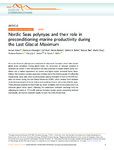Nordic Seas polynyas and their role in preconditioning marine productivity during the Last Glacial Maximum.
| dc.contributor.author | Knies, J | |
| dc.contributor.author | Köseoğlu, D | |
| dc.contributor.author | Rise, L | |
| dc.contributor.author | Baeten, N | |
| dc.contributor.author | Bellec, VK | |
| dc.contributor.author | Bøe, R | |
| dc.contributor.author | Klug, M | |
| dc.contributor.author | Panieri, G | |
| dc.contributor.author | Jernas, PE | |
| dc.contributor.author | Belt, Simon | |
| dc.date.accessioned | 2018-10-15T09:43:57Z | |
| dc.date.issued | 2018-09-27 | |
| dc.identifier.issn | 2041-1723 | |
| dc.identifier.issn | 2041-1723 | |
| dc.identifier.other | 3959 | |
| dc.identifier.uri | http://hdl.handle.net/10026.1/12536 | |
| dc.description.abstract |
Arctic and Antarctic polynyas are crucial sites for deep-water formation, which helps sustain global ocean circulation. During glacial times, the occurrence of polynyas proximal to expansive ice sheets in both hemispheres has been proposed to explain limited ocean ventilation and a habitat requirement for marine and higher-trophic terrestrial fauna. Nonetheless, their existence remains equivocal, not least due to the hitherto paucity of sufficiently characteristic proxy data. Here we demonstrate polynya formation in front of the NW Eurasian ice sheets during the Last Glacial Maximum (LGM), which resulted from katabatic winds blowing seaward of the ice shelves and upwelling of warm, sub-surface Atlantic water. These polynyas sustained ice-sheet build-up, ocean ventilation, and marine productivity in an otherwise glacial Arctic desert. Following the catastrophic meltwater discharge from the collapsing ice sheets at ~17.5 ka BP, polynya formation ceased, marine productivity declined dramatically, and sea ice expanded rapidly to cover the entire Nordic Seas. | |
| dc.format.extent | 1-10 | |
| dc.format.medium | Electronic | |
| dc.language | en | |
| dc.language.iso | en | |
| dc.publisher | Nature Research (part of Springer Nature) | |
| dc.subject | 0405 Oceanography | |
| dc.subject | 0406 Physical Geography and Environmental Geoscience | |
| dc.title | Nordic Seas polynyas and their role in preconditioning marine productivity during the Last Glacial Maximum. | |
| dc.type | journal-article | |
| dc.type | Journal Article | |
| dc.type | Research Support, Non-U.S. Gov't | |
| plymouth.author-url | https://www.ncbi.nlm.nih.gov/pubmed/30262866 | |
| plymouth.issue | 1 | |
| plymouth.volume | 9 | |
| plymouth.publication-status | Published online | |
| plymouth.journal | Nature Communications | |
| dc.identifier.doi | 10.1038/s41467-018-06252-8 | |
| plymouth.organisational-group | /Plymouth | |
| plymouth.organisational-group | /Plymouth/Faculty of Science and Engineering | |
| plymouth.organisational-group | /Plymouth/Faculty of Science and Engineering/School of Geography, Earth and Environmental Sciences | |
| plymouth.organisational-group | /Plymouth/REF 2021 Researchers by UoA | |
| plymouth.organisational-group | /Plymouth/REF 2021 Researchers by UoA/UoA07 Earth Systems and Environmental Sciences | |
| plymouth.organisational-group | /Plymouth/Research Groups | |
| plymouth.organisational-group | /Plymouth/Research Groups/Marine Institute | |
| plymouth.organisational-group | /Plymouth/Users by role | |
| plymouth.organisational-group | /Plymouth/Users by role/Academics | |
| plymouth.organisational-group | /Plymouth/Users by role/Researchers in ResearchFish submission | |
| dc.publisher.place | England | |
| dcterms.dateAccepted | 2018-08-28 | |
| dc.rights.embargodate | 2019-1-11 | |
| dc.identifier.eissn | 2041-1723 | |
| dc.rights.embargoperiod | Not known | |
| rioxxterms.version | Version of Record | |
| rioxxterms.versionofrecord | 10.1038/s41467-018-06252-8 | |
| rioxxterms.licenseref.uri | http://www.rioxx.net/licenses/all-rights-reserved | |
| rioxxterms.licenseref.startdate | 2018-09-27 | |
| rioxxterms.type | Journal Article/Review |


